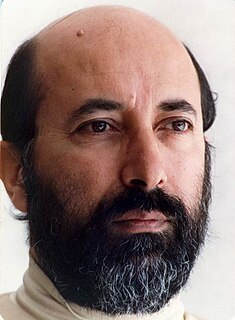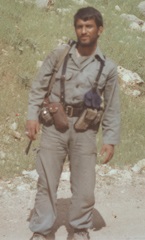 W
WHassan Abshenasan was one of the commanders of the Ground Forces of Islamic Republic of Iran Army who was killed in the Iran–Iraq war.
 W
WAbbas Babaei was an Iranian Air Force pilot who served as Brigadier-General during the Iran-Iraq War.
 W
WMohammad Boroujerdi was an Iranian Islamic Revolutionary Guard Corps commander during the Iran–Iraq War. He played key roles in regaining control over the territories of Kurdistan by Iranian forces.
 W
WMostafa Chamran Save'ei was an Iranian physicist, politician, commander and guerrilla fighter who served as the first defense minister of post-revolutionary Iran and a member of parliament, as well as the commander of paramilitary volunteers in Iran–Iraq War, known as "Irregular Warfare Headquarters". He was killed during the Iran–Iraq War. In Iran, he is known as a martyr and a symbol of an ideological and revolutionary Muslim who left academic careers and prestigious positions as a scientist and professor in the US, University of California, Berkeley and migrated in order to help the Islamic movements in Palestine, Lebanon, Egypt as a chief revolutionary guerilla, as well as in the Islamic revolution of Iran. He helped to found the Amal Movement in southern Lebanon.
 W
WAbbaas Dowraan was an acclaimed fighter pilot and is regarded as a national hero of Iran.
 W
WAli Eghbali Dogahe was an Iranian pilot and Major General in the Islamic Republic of Iran Air Force, during the Iran-Iraq War. His date of death cannot be confirmed as he died while he was a Prisoner of war in Iraq.
 W
WMohammad Hossein Fahmideh was an Iranian war hero and an icon of the Iran–Iraq war.
 W
WAli Hashemi, commonly known as "Shahid Ali Hashemi" is among the Iranian commanders during Iran–Iraq War. He was born in 1961 in Ahwaz. This Iranian Arab commander who got married in 1984 and had a son and a daughter, was appointed as the commander of "the 6th army of Imam Sadiq" in 1987, and he managed several brigades, divisions (military), Basij and Khuzestan/Lorestan Sepah, and likewise was appointed as the commander of "Nosrat secret headquarters" at the third year of the war by Mohsen Rezaee.
 W
WMohammad Ebrahim Hemmat was a teacher and an Iranian military leader. He was one of the highest ranking officers of the Islamic Revolutionary Guard Corps during the Iran-Iraq War. In 1982, he spent a few months fighting against Israel during the 1982 Lebanon War. He then returned to Iran and held commanding roles in several missions during the Iran-Iraq War. He was killed in March 1984 in Operation Kheibar.
 W
WHassan Jangju was an Iranian Basiji during the Iran–Iraq War who became subject to an iconic photograph taken by Alfred Yaghobzadeh in 1980. He was missed in action in 1984, and his body was returned to Iran in 2017.
 W
WGhafour Jeddi Ardabili was an Iranian McDonnell Douglas F-4 Phantom II fighter pilot in the Air Force of Iran. He played a significant role in the early months of the Iran-Iraq War by halting the advancement of Iraqi tanks into the Western Iran. A statue in honor of him is placed in Tehran and in his hometown of Ardabil.
 W
WAhmad Keshvari was an AH-1J SeaCobra pilot in the Army Aviation (Havanirooz) of Iran. He had a role in the early months of the Iran-Iraq War to stop Iraqi tanks from further advancing into the western Iranian territories.
 W
WMajor General Hossein Kharrazi was the commander of IRGC's 14th Imam Hussein Division during Iran–Iraq War. He supported Islamic revolution and after its victory, served and helped safeguarding it. He was engaged in many operations during the war, namely Dawn 8, in which he captured troops of Saddam's Republican Guard in al-Faw Peninsula; and in Operation Karbala-5 as the commander of the vanguard forces. Kharrazi was killed by shrapnel from a mortar bomb during Operation Karbala-5.
 W
WNader Mahdavi or Hossein Basria was an Islamic Revolutionary Guard Corps naval commander who fought against United States naval forces and cruisers on 24 July 1987.
 W
WHossein Qajeyi was one of the commanders of 27th Mohammad Rasulullah Division in the Iran-Iraq war.